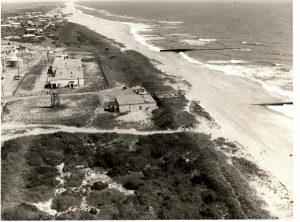
The Buxton Civic Association (BCA) recently launched a Change.org petition to encourage the public to demand an immediate solution for the environmental and public safety hazards at Buxton Beach.
The online petition is part of a flood of recent initiatives by the BCA to quickly facilitate a resolution for the roughly 500-yard shoreline at the end of Old Lighthouse Road in Buxton, which is the site of a number of environmental and public safety hazards that have surfaced over the past seven months.
The shoreline in question is part of a 50-acre site that was utilized by the Navy from 1956-1982, and the Coast Guard from 1984-2010. Both military branches operated the property under an agreement with the National Park Service that the area and beaches would be returned to their natural, pristine condition once the military agencies left the area.

With these agreements in place, in 1998, the U.S. Army Corps of Engineers (USACE) approved the Buxton Beach area as a Formerly Used Defense (FUDS) site, which allows the USACE to address environmental liabilities that stem from Department of Defense activities.
In the years that followed, the USACE removed abandoned buildings and structures, including the Navy’s former Terminal Building which was used for submarine detection during the height of the Cold War.
The USACE also removed 4,006 tons of petroleum-contaminated soils (PCS) in the early 2000s, while the Coast Guard removed some – but not all – of the buildings and wastewater facilities that they relied on prior to their departure in 2010.
“In a communication dated January 2005, the US Army Corps of Engineers acknowledges its responsibility of this FUDS [site],” reads the Change.org petition. “[The report states] ‘Area I was not excavated to the full extent as presented in the Workplan due to the presence of underground concrete slabs and critical utilities.’”
These remaining issues were buried for years, but a pair of offshore hurricanes in the fall of 2023 resulted in accelerated erosion in the Buxton area, causing these issues to resurface.
Most notably, the foundational remnants of the Terminal Building and adjacent structures are now clearly visible on the Buxton shoreline, and petroleum smells in the immediate area have been routinely reported over the past seven months.
As a result, a beach closure is in place for a three-tenth-of-a-mile section of Buxton shoreline, however, there are obvious implications that the problem could easily spread and affect a much larger area, through inherent air-born and water-born transportation.
In late March, the USACE stated that after months of investigations, additional study was required to determine the next steps.
An excerpt from that March 27 press release is as follows:
The U.S. Army Corps of Engineers’ FUDS Program addresses environmental liabilities that resulted from Department of Defense activities at eligible properties. For a property to be eligible for the FUDS Program, it must have been formerly owned by, leased to, or otherwise possessed, by the United States and then transferred outside of DoD control prior to Oct. 17, 1986. For a project to be eligible, there must be known or potential contamination or hazards attributable to DoD activities occurring prior to Oct. 17, 1986, and associated with the property.
“The limiting factor we’ve run into is program policy specifically states, hazards that arise after a property is transferred out of DoD control are not FUDS eligible,” said Sara Keisler, USACE, Savannah District, FUDS Program Manager. “But, if the source of the recently reported petroleum contamination is the result of DoD activities prior to Oct.17, 1986, then the FUDS Program can be used to clean up the area.”
The former Buxton Naval Facility is owned by the National Parks Service, and it was used by the U.S. Navy from 1956 to 1982, under a special use permit from the NPS. There were underground storage tanks with petroleum products when the Navy used it. Those tanks leaked, and USACE completed removal of the tanks and the saturated soil in the early 2000s.
The Army Corps of Engineers will continue working with its partners to assess whether recently reported contamination is linked to DoD activities prior to 1986. However, remedial action using the FUDS Program is not authorized due to an unknown source. Additionally, the concrete structures that were uncovered after years of erosion on the beach were not associated with the petroleum or the initial cleanup of the area that occurred in the 1990s, which also means those remnants are currently ineligible for removal under the FUDS Program.”

The BCA has been in contact with the USACE since forming in early April, and is working on forming a Restoration Advisory Board (RAB) that will create a direct line of communication between the Buxton community and the USACE on remediation efforts.
But other corresponding initiatives by the BCA are in the works too, including a recent partnership with the Southern Environmental Law Center (SELC) to push for remediation efforts, and to keep the issue on the public’s radar.
When the BCA hosted its first meeting on April 10, the five Board Members present – Jason Hall, Brian Harris, Heather Gray Jenette, Jeff Dawson and Wendi Munden – made it clear that they were exploring every option at their disposal to fix the Buxton Beach situation as soon as possible.
“Give us a chance,” said Board Member Jason Hall at the April 10 meeting. “We are all on your side. We’re just your face for now in this fight, that’s it. Everybody is welcome to step up.”
In that vein, the Change.org petition is just one cog in a larger, home-grown machine that is working hard to fix Buxton Beach as soon as possible, by exploring every avenue available.
For more information, and how to get involved
- The Buxton Civic Association meets every Tuesday at 6:30 p.m. at the old Buxton Volunteer Fire Department building beside Burrus Field. The public is welcome and encouraged to attend.
- Developing info from the BCA can be accessed via the organization’s new website at Buxtoncivic.com or through the BCA’s official Facebook page at https://www.facebook.com/buxtonnccivicassociation
- The public can also join the ongoing email and letter-writing campaign, which was launched in mid-March by Buxton community members.
- Visitors who encounter a fuel smell or fuel sheens while visiting the Buxton shoreline near Old Lighthouse Road should call the National Response Center at 1-800-424-8802 to report the encounter. Include the date, time, location, and basic details of what was seen or smelled, and do not call if you have not experienced the issue first-hand, or have not been physically affected.
- For more information on the background of the current Buxton Beach issues, click here. The Cape Hatteras National Seashore has also launched a new webpage that outlines the history of the site, and the current issues.
- Remember that while the environmental issues at Buxton Beach are considered to be a growing emergency, just three-tenths of a mile of the shoreline is closed, out of 75 miles of National Seashore. In short, the public can still visit and enjoy Buxton, and Hatteras Island in general. The primary concern is that this issue needs to be addressed now, before it has the time and weather-driven opportunity to spread.









